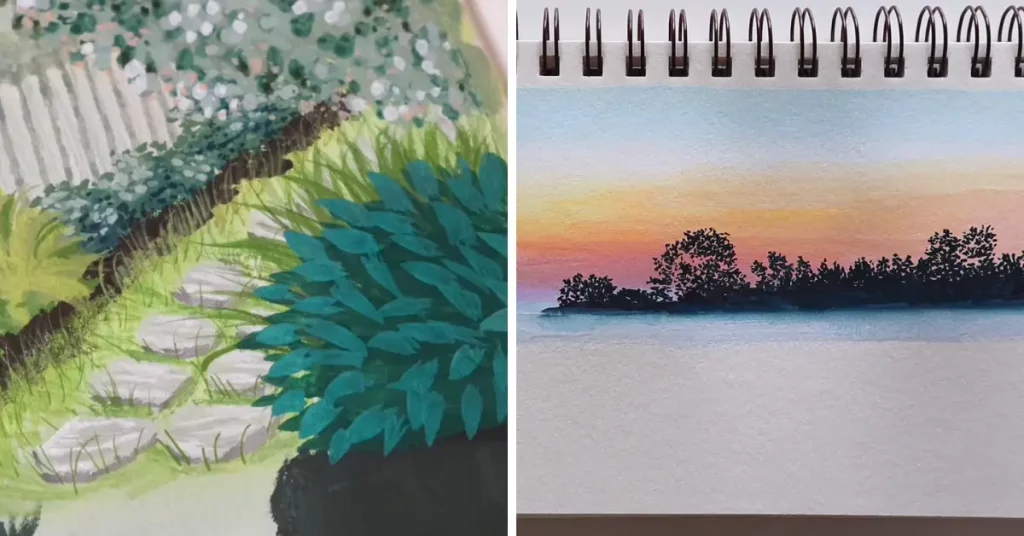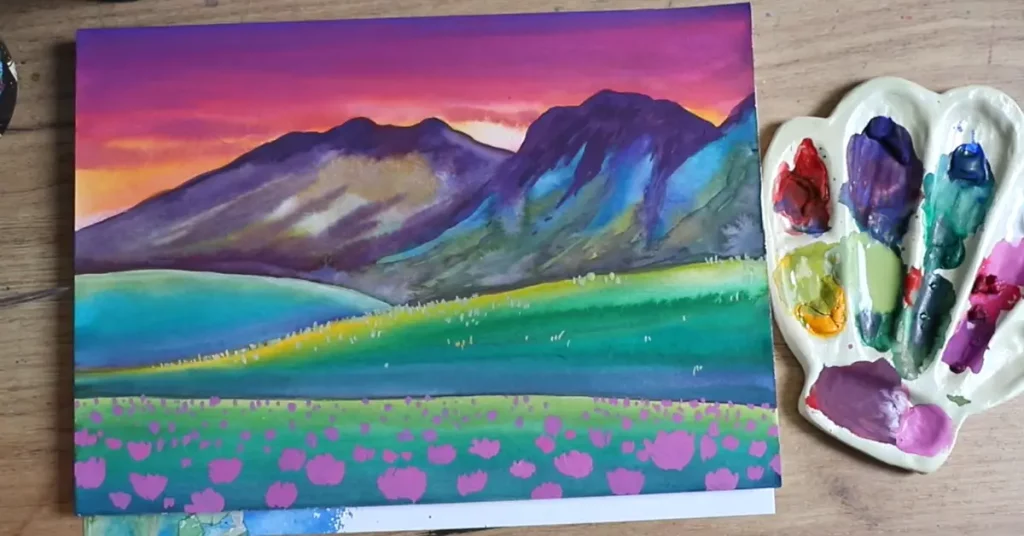If you are new to the world of art, you are already familiar with the name “gouache.” However, if you are new to art, I know you often mix up gouache and jelly gouache. Even though the main difference lies in their names, it is difficult for beginners to distinguish them. Therefore, I will discuss “Jelly gouache vs. gouache” in this article.

Gouache is a thicker form of watercolor that incorporates more gum Arabic binder and similar dry pigments as transparent watercolor. As a result, one can use it as a watercolor with more water or as an oil /acrylic color with a thick application. In contrast, Jelly gouache is a more recent addition to the gouache family that has a jelly-like consistency to give your artwork a more dynamic texture.
Keep reading to discover more about Gouache and Jelly Gouache, their key features, and differences. So, let’s start.
What is Gouache?
Gouache is a more dense form of watercolor. Like other colors, it also has three vital components of paints: a binder, a liquid solvent, and pigments. But Gouache paints are unique to the extent that people can use them as watercolor and acrylic colors. Since Gouache includes a high proportion of non-toxic, quick-drying Arabic Gum as a binder, it can act as acrylic if thickly applied. In contrast, if you add more water to the color, it will act as watercolor. Just like watercolor, artists can reactive the dried colors even after several years since it is water-soluble.
However, Gouache’s dry pigments don’t sit as delicately as watercolors do due to the excessive amount of binder, producing a thicker, heavier texture in the final product. To solve this problem, superior quality Gouache paints contain a greater percentage of dry pigment, whereas moderate quality paints use precipitated chalk or blanc fixe to improve their smoothness.

Key features of Gouache:
- Gouache comes in various packaging, including tubes, pans, and jars.
- It is ideal for layering and adding details due to greater thickness.
- Instead of the white surface of the paper, Gouache’s brightness derives from the pigment & paint film’s outer layer.
- It dries quickly.
- Gouache is reactivable due to its water-soluble nature
- It offers a good coverage power
- If applied too thickly, it may fracture or peel.
What is Jelly Gouache?
Jelly Gouache is a version of Gouache paint. So, what is “jelly” in jelly gouache? The jelly basically refers to the jelly-type consistency of the colors. It has a thick and sticky consistency that sits on the ground flawlessly due to its jelly-type thickness. Therefore, creating layers or highlighting an object, textured surfaces, or 3D-like forms have become so easy with jelly gouache.
Besides, it is super easy to blend and takes comparatively more time to dry than traditional Gouache. Most importantly, it provides a glossy finish in the final product that you won’t find in Gouache. This feature has made it immensely popular among illustrators and designers.
The gouache painters often claim that the gouache colors change shades when dried out. However, jelly gouache is a fantastic alternative in this regard because it dries to the same shade.

Key features of Jelly Gouache
- Jelly Gouache has a thick, sticky consistency.
- It is better suitable for illustration, fine arts, textured surfaces, and 3D-like forms.
- Jelly Gouache doesn’t require water to activate. Therefore, it needs no preparation before painting.
- When dried, the Jelly Gouache colors retain their original color.
- These colors are a bit difficult to blend smoothly due to the gummy texture.
Jelly Gouache vs. Gouache
I have listed below the main differences between gouache and Jelly gouache:
| Criteria | Gouache | Jelly Gouache |
| Function | It can act both as a watercolor and acrylic color | It works more like acrylic color |
| Finishing effect | It dries matte with a full coverage | It dries glossy |
| Reactivation | Gouache needs water to be reactivated | It requires no water |
| Changing colors | the dried colors are a bit different from the original one | Jelly gouache paints can retain their actual colors when dried |
| Binder | Arabic Gum | Acrylic polymer emulsion |
| Suitable base | Paper | paper, canvas, cardboard, wood, fabric, etc. |
| Drying time | Quick | Require more time due to greater thickness |
Check acrylic gouache vs gouache to understand how these forms of gouache paint vary.
FAQs:
Why is Jelly Gouache Good?
Jelly gouache is good because these paints are wet and that’s why they remain prepared in their cups. They are always ready to use, so you don’t need any prior preparations to use them. They are very easy to use and that’s why these paints are very preferable.
Is Jelly Gouache Worth It?
These paints are great for beginner artists and they offer vibrant colors. As jelly gouache comes in wet form, you don’t need to use water to prepare it. Thus the paint gives you a proper consistency without any hassle. Yes, this paint is worth it.
Do You Add Water To Jelly Gouache?
No, you don’t need to add water to jelly gouache. This paint comes in wet form and remains in a jelly-like form in their cups. So, you don’t need to use anything extra to dissolve the paint.
Conclusion:
Gouache paints have created a new variety in the world of art. Since it comes in different types, such as traditional Gouache, jelly gouache, acrylic gouache, etc, many people struggle to differentiate them. Therefore, I have gone over “jelly gouache vs. gouache” in this article with essential features and central areas of differences. Besides, I have provided the main distinctions between acrylic Gouache and Gouache. I hope the readers will be able to differentiate them from now on.

S. Pushon is a paint expert, self-taught artist, and currently working as an adviser in the paint industry as a Quality Improvement and Development Assistant.
An artist by heart, he draws remarkable art pieces and as a professional paint industry individual, he seeks the insight and shares with enthusiasts. Read more…
